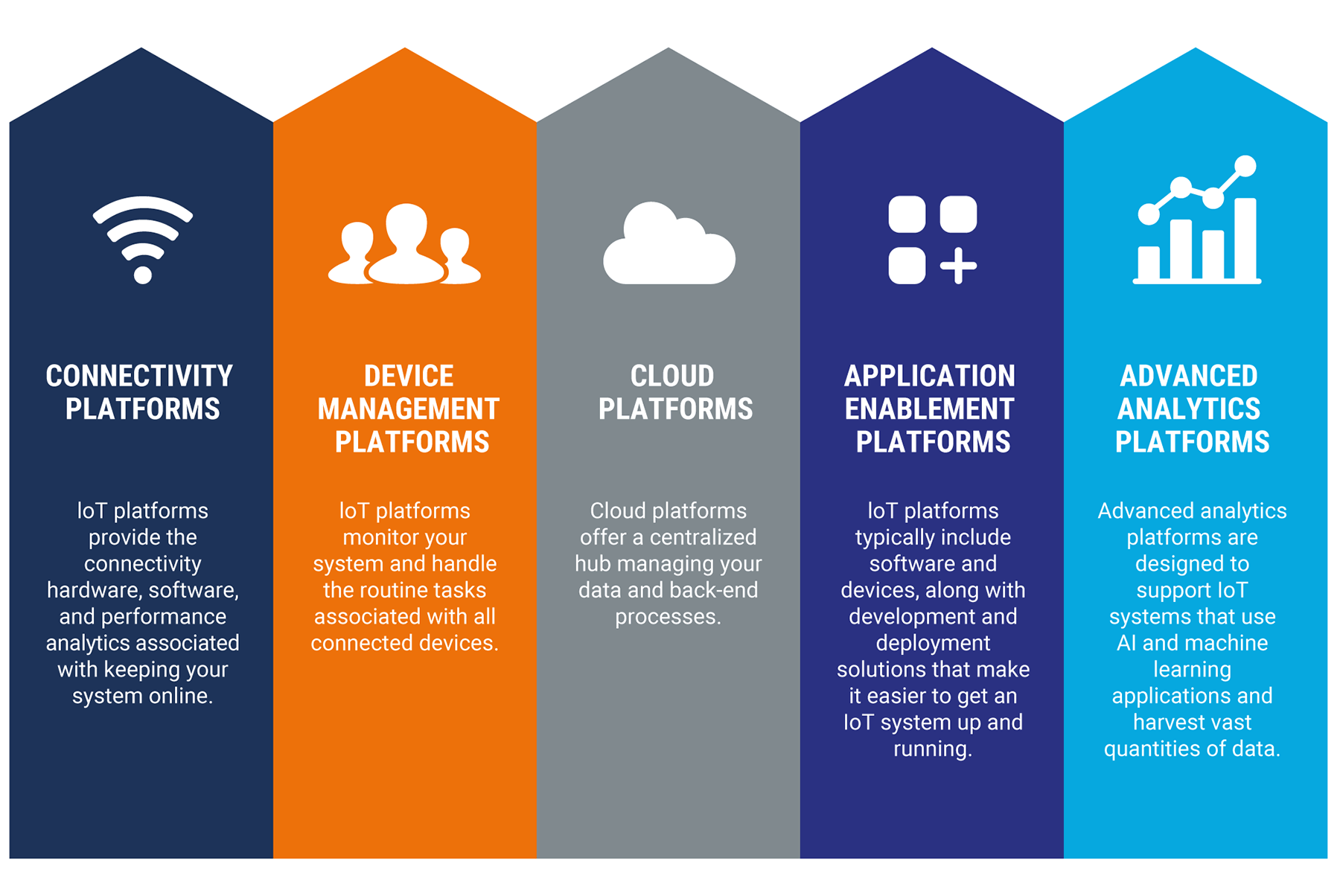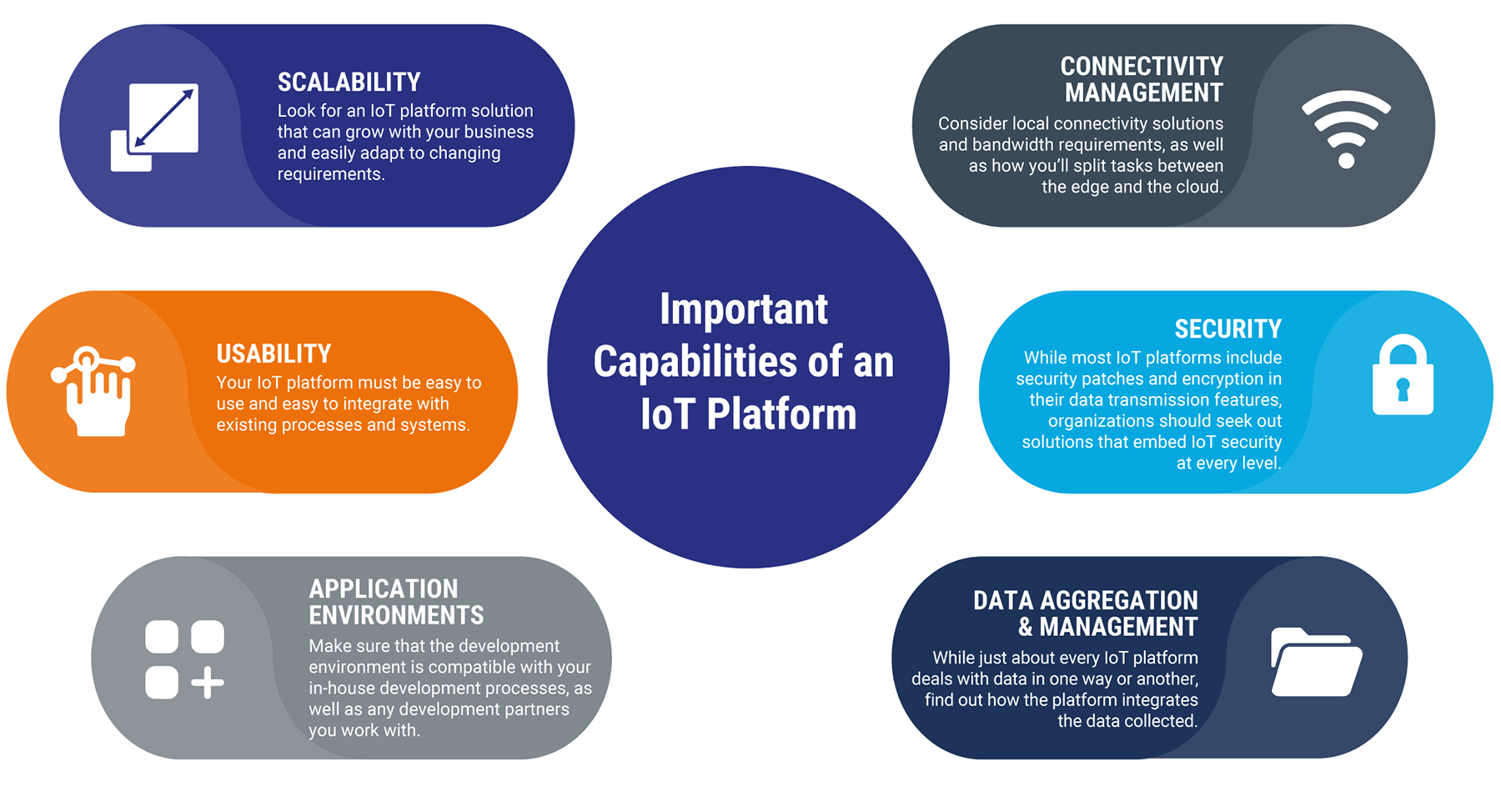Things To Consider When Selecting An IoT Platform
Industrial Internet of Things (IIoT) solutions are fast becoming the key to securing a competitive advantage, allowing businesses to access new business models and markets.
Of course, IoT is an expansive category spanning a wide range of components, from sensors and retro-fitted legacy equipment to networks, infrastructure, and data storage. The challenge is to build a system where all of these disparate components work together in a way that supports an organization’s business goals.
An IoT platform seeks to address that challenge, offering a suite of technologies that bridge the gap between the various sensors, assets, devices, and software within an IoT system. While IoT platforms are a critical piece of any connected system, there’s some confusion as to what an IoT platform does and how to find the best solution in an increasingly crowded sea of options.
Below, we’ll explain what an IoT platform is and what capabilities businesses should look for when evaluating vendors.
What is an IoT Platform?
IoT platforms are a type of middleware, meaning, they’re designed to act as a mediator between the hardware and application layers.
In heterogeneous IoT environments, platforms support integration between third-party apps, sensors, legacy equipment, and other connected devices, allowing organizations to manage all activities in the same straightforward manner.
Much like the operating system on a computer, platforms work behind-the-scenes to manage application functionality, devices, and data flow, as well as facilitate seamless communication across the entire IoT system.
While IoT platform solutions vary considerably, they generally offer the following capabilities:
- Connect devices, sensors, machines, etc.
- Handle multiple types of communications protocols.
- Secure devices, data, and networks.
- Capture, analyze, and organize data collected from various devices.
- Integrate IoT systems with existing business processes like inventory management, CRMs, etc.
Ultimately, industrial IoT platforms should reduce costs and associated risks of developing and maintaining applications.
Understanding the Various Categories of IoT Platforms

Now that we’ve established a basic idea of what an IoT platform does, it’s important to mention that there are a few different types of platforms within that broader category.
Here, we’ll quickly go over the five main categories of IoT platforms and their use cases.
- Connectivity Platforms. As you might imagine, connectivity platforms are designed to manage the networking aspects of an IoT system. These platforms provide the connectivity hardware, software, and performance analytics associated with keeping all devices in your system online. These platforms are typically offered through existing WiFi providers and carrier services that configure the connection allowing for easy set-up.
- Device Management Platforms. Device management platforms are used to ensure that all devices in an IoT system are secure and connected. These platforms monitor your system and handle the routine tasks associated with all connected devices. Think firmware updates, patching, reporting, and alerting users to any device-related changes.
- Cloud Platforms. Cloud platforms are used to provide organizations with the infrastructure needed to build out an IoT system. Essentially, cloud platforms offer a centralized hub managing your data and backend processes.
- Application Enablement Platforms. Application enablement platforms are designed as an all-in-one solution that offer the full range of tools needed to get an IoT system up and running. These platforms typically include software and devices, along with development and deployment solutions that make it easier to get an IoT system up and running. The benefit here is that enablement platforms take care of the development, network configuration, and installation typically done in-house–potentially saving organizations time and money.
- Advanced Analytics Platforms. Advanced analytics platforms are designed to support IoT systems that use AI and machine learning applications and harvest vast quantities of data. These IoT platforms extract critical insights in real-time, enabling rapid decision-making.
What Are the Important Capabilities of an IoT Platform?
While much of your decision-making process depends on your business needs, some key capabilities remain consistent regardless of industry or use case.
Here, we’ve outlined some of the main things to consider during the IoT planning process:
- Scalability. Your IoT platform solution should be equipped to scale with you as your business grows. Ask prospective partners whether scaling up will require significant investments in new hardware or time-consuming configuration efforts. Ideally, your solution should be able to accommodate new devices and software with relative ease.
- Usability. Your IoT platform must be easy to use and easy to integrate with existing processes.
- Applications Environment. When assessing a platform’s application environment, there are a few key things to consider. First, does the platform come with any built-in applications that address your business needs? Second, does it allow you to develop IoT applications in-house? You’ll want to make sure that the development environment is compatible with your in-house development processes, as well as any development partners you work with. Look for platforms that support containerization via common service providers. This will allow you to transfer applications to another platform should you find a better solution down the road. Additionally, you might also want to look toward platforms that integrate with existing enterprise software such as enterprise-resource-planning systems (ERPs) or CRMs.
- Connectivity Management. What kind of connectivity requirements do you have? Will you need a cellular connection, or will your existing WiFi be sufficient? Do you need a platform that enables data processing at the edge? If so, you’ll need to consider local connectivity solutions and bandwidth requirements, as well as how you’ll split tasks between the edge and the cloud.
- Security. One of the biggest risks of introducing IoT technologies into your business processes is security. While most IoT platforms include security patches and encryption in its data transmission features, organizations should seek out solutions that embed IoT security at every level. Additionally, seek out platforms that offer distinctive monitoring, authentication, or encryption capabilities that offer something beyond base-level protections.
- Data Aggregation & Management. While just about every IoT platform deals with data in one way or another, find out how the platform integrates the data collected. Consider whether the platform can rapidly process incoming data streams. If your goal is to capture insights at the edge, your solution must be able to serve up real-time insights that enable quick decision-making. The other big thing to look at is how the platform handles data coming from multiple sources including 3rd party platforms, operational technology (or, OT, which refers to things like manufacturing and construction equipment or vehicles), and various business tools. Look for solutions that join disparate data sets together and provide a holistic view of the end-to-end process.
What Benefits Does an Enterprise-Ready IoT Platform Offer Businesses?
Building an entire IoT system from scratch is a massive undertaking, requiring expertise across many different domains.
An enterprise-ready industrial IoT platform is composed of a variety of protocols, tools, and SDKs that support a wide range of IoT solutions, allowing organizations to build out their IoT environment on a solid foundation.
These solutions remove many of the risks associated with adoption, reduce costs, accelerate time-to-market, and maintain quality standards. The vendor takes care of feature updates, bug fixes, and patching so that organizations can allocate their resources toward other activities.
IoT Platform Evaluation Criteria: Checklist
We’ve gone over the benefits of using an IoT platform and typical capabilities, offering a better idea of what you might look for in a platform. Here, we’ve included a checklist that includes what we’ve outlined in the above sections, which provides a starting point for conversations with solution providers.
Does the platform provide an environment for developing, testing, and maintaining applications?
Does it come with prewritten applications?
Can the IoT platform connect with existing business applications?
Is it equipped to handle large data volumes?
How does the platform clean, format, and organize data?
Does the platform have the ability to connect unstructured data from multiple sources?
How user-friendly is the platform?
How scalable is it?
What kind of cybersecurity capabilities does it have?
Can the platform be configured to self-adjust local assets at the edge?
Is the IoT platform open and developer-friendly?
What is the IoT vendor’s reputation?
What does the pricing model look like?
What are the primary use cases of the IoT platform?
How long will it take to get to market?
How will the vendor support you during implementation?
Keep in mind that every organization has a different set of needs. As such, you’ll likely want to add more questions to this list that speak directly to your business objectives and potential use cases.
Bottom Line: The Right IoT Platform Can Elevate Your Business
Whether you’re in manufacturing, energy, healthcare, or logistics, your operations and IT teams will have a list of problems and opportunities to address to improve business processes.
Selecting the right IoT platform begins by taking a close look at your pain points and business objectives. Which processes are you trying to improve?
For example, transportation companies and local utilities might search for solutions that monitor equipment performance and protect assets from harsh environmental conditions. Manufacturers might focus more on applying AI-enabled solutions to the assembly line or gathering insights from legacy equipment.
Closely look at how the vendor describes the solution; some services are industry-specific or focus exclusively on device management. Others offer end-to-end solutions that handle everything from hardware and software to connectivity and analytics. Additionally, the right platform should make it easy to manage and secure all connected elements from one user-friendly interface.
[adinserter name=”IIoT Closing”]
Recent blog posts

Stay in Touch
Keep your competitive edge – subscribe to our newsletter for updates on emerging software engineering, data and AI, and cloud technology trends.




